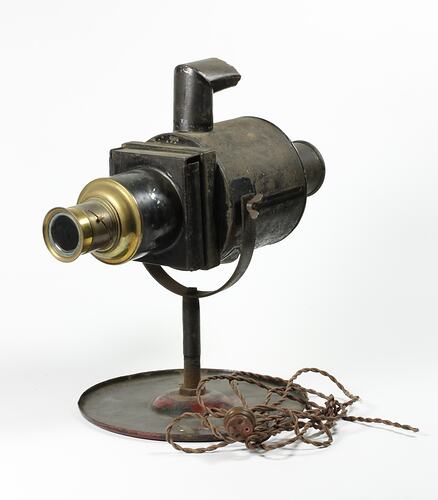Summary
Metal magic lantern that operates by using electricity to provide the illumination.
While the invention of the magic lantern is generally seen to be in the 17th century, its greatest popularity as an optical projector spans the late 18th century to the early decades of the 20th century. It was used both as a means of entertainment and education.
This lantern projector is part of the Francis Collection of pre-cinematic apparatus and ephemera, acquired by the Australian and Victorian Governments in 1975. David Francis was the curator of the National Film and Sound Archive of the British Film Institute as well as being a co-founder of the Museum of the Moving Image in London, which was operational between 1988 and 1999.
Physical Description
Black tubular metal body, brass lens tube and fixed metal elbow chimney. Flat circular base with remnant red enamel finish. Base has x6 holes drilled through it. Lantern body attached to base by metal cradle and stand by wing nuts on either side of body. Electrical illumination. Back of body designed to come away from lantern to allow internal access (stuck). Electrical cord with two pronged turned wooden plug. Plug has only one prong.
More Information
-
Collection Names
-
Collecting Areas
-
Acquisition Information
Loan & Subsequent Donation from Australian Film Institute (AFI), Mr David Francis, by Nov 1990
-
Collector
Mr David Francis, London, Middlesex, England, Great Britain, 1990
-
Date Made
-
Inscriptions
On circular paper sticker: '490'
-
Classification
-
Category
-
Discipline
-
Type of item
-
Overall Dimensions
440 mm (Length), 160 mm (Width), 420 mm (Height)
-
Keywords
Lantern Projectors, Magic Lanterns, Pre-Cinema Moving Images, Projectors

